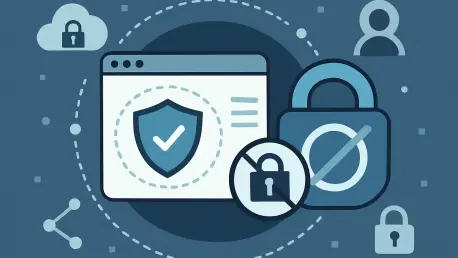What happens when a contractor logs into a corporate system from a personal laptop, bypassing every security measure in place? In today’s distributed work environments, such scenarios are not just possible—they’re alarmingly common, and unmanaged devices, often brought into enterprise networks through bring-your-own-device (BYOD) policies, represent a gaping hole in cybersecurity defenses. This vulnerability has spurred innovation, with Cato Networks stepping forward with a groundbreaking solution that promises to secure these endpoints without sacrificing usability.
The significance of this development cannot be overstated. As remote and hybrid work models continue to dominate, traditional security perimeters have crumbled, leaving IT teams scrambling to protect sprawling networks. Cato Networks’ latest offering, a Zero-Trust Browser Extension, tackles this challenge head-on by extending robust security to unmanaged devices. This isn’t just a technical fix; it’s a strategic shift toward a more resilient, adaptable approach to enterprise protection.
Unmanaged Devices: The Hidden Threat to Enterprise Security
Unmanaged devices pose a silent but deadly risk to organizations worldwide. A 2025 study by Cybersecurity Insiders revealed that over 60% of data breaches involve endpoints outside direct IT control, such as personal laptops or third-party tablets. These devices often lack the security patches and oversight of managed systems, making them easy targets for phishing attacks or malware infiltration.
The rise of remote work has only amplified this issue. Employees and contractors frequently access sensitive data from personal hardware, often without realizing the potential consequences. A single compromised device can serve as a gateway for attackers to infiltrate an entire network, exposing critical assets to theft or disruption.
This growing threat underscores the urgent need for innovative solutions. While traditional tools like VPNs offer some protection, they often fall short in scalability and ease of use, leaving gaps that cybercriminals exploit. Addressing this weak link is no longer optional—it’s a business imperative.
Zero-Trust: The New Standard for a Distributed Workforce
As organizational boundaries blur, the concept of zero-trust network access (ZTNA) has emerged as a cornerstone of modern cybersecurity. Unlike outdated perimeter-based models that assume trust within the network, zero-trust operates on the principle of “never trust, always verify.” This shift is critical in environments where employees work from diverse locations and devices.
Unmanaged endpoints often evade conventional security measures, creating blind spots for IT teams. Without consistent oversight, these devices can become conduits for unauthorized access or data leaks. Zero-trust addresses this by enforcing strict identity verification and access controls, regardless of device status or location.
Integrating ZTNA into platforms like Secure Access Service Edge (SASE) offers a unified framework for protection. This convergence allows organizations to apply consistent policies across all endpoints, reducing complexity and enhancing visibility. Such an approach is proving transformative for enterprises navigating the challenges of a distributed workforce.
Inside the Cato Browser Extension: Features That Transform Security
Cato Networks has introduced a powerful tool with its Browser Extension, a lightweight Google Chrome add-on designed to bring zero-trust security to unmanaged and BYOD endpoints. This extension seamlessly integrates with the Cato SASE platform, eliminating the need for additional software installation. It ensures that even personal devices adhere to the same stringent security standards as managed systems.
A standout feature is its ability to enforce uniform policies across diverse environments. Whether accessing resources from a corporate laptop, a contractor’s tablet, or a remote desktop, users experience consistent protection driven by identity-aware frameworks. This reduces the risk of policy gaps and simplifies compliance with regulatory requirements through improved audit readiness.
Operationally, the extension delivers significant benefits. By minimizing reliance on cumbersome VPNs, it streamlines access for users while easing the burden on IT teams. For businesses of all sizes, this translates to faster deployment and lower management overhead, making robust security more accessible than ever.
Balancing Protection and Usability: Expert Perspectives
Striking a balance between security and user experience remains a top priority in cybersecurity innovation. Ofir Agasi, Chief Product Officer at Cato Networks, highlighted the extension’s design philosophy, stating, “It provides simple access for users and complete policy control for IT.” This dual focus ensures that protective measures don’t hinder productivity or frustrate end-users.
Industry trends support this emphasis on usability. A 2025 report by Gartner noted that 70% of enterprises prioritize solutions that integrate seamlessly into existing workflows, avoiding the pitfalls of overly complex systems. Tools that demand extensive training or disrupt daily operations often face resistance, undermining their effectiveness.
Consider a scenario where an IT manager needs to secure a contractor’s personal device for a short-term project. With this browser-based solution, access can be granted and monitored effortlessly, without requiring invasive software or lengthy setup processes. Such practical applications demonstrate how advanced security can coexist with user convenience.
A Roadmap to Securing Unmanaged Devices with Zero-Trust
For IT professionals seeking to implement zero-trust for unmanaged devices, a structured approach is essential. Start by assessing the scope of BYOD and third-party endpoints within the network. Mapping out these assets provides a clear picture of potential vulnerabilities and informs targeted security strategies.
Next, configure existing ZTNA policies to incorporate the Cato Browser Extension for consistent enforcement. This step ensures that unmanaged devices are subject to the same access controls and monitoring as their managed counterparts. Leveraging the Cato SASE Cloud Platform’s global backbone, with over 90 points of presence, further optimizes performance and minimizes latency for users worldwide.
Finally, focus on ongoing evaluation and refinement. Regularly review policy effectiveness and user feedback to address emerging challenges. By embedding these practices into daily operations, organizations can maintain a robust security posture without adding unnecessary complexity to IT workflows.
Reflecting on a Security Milestone
Looking back, the launch of the Cato Browser Extension marked a turning point in how enterprises approached the challenge of unmanaged devices. It bridged a critical gap in cybersecurity, offering a scalable, user-friendly solution that aligned with the realities of distributed work. This innovation set a new benchmark for integrating zero-trust principles into everyday operations.
For organizations moving forward, the next steps involve prioritizing comprehensive endpoint protection strategies. Exploring integrated SASE platforms that consolidate security functions promises to further reduce complexity and enhance resilience. Staying ahead of evolving threats requires continuous adaptation and investment in tools that support both security and operational goals.
Beyond immediate implementation, the broader implication is clear: the future of enterprise security lies in unified, adaptable frameworks. Embracing solutions that evolve with workforce dynamics ensures that businesses remain protected against emerging risks. This reflection underscores the importance of proactive planning in an ever-changing digital landscape.









